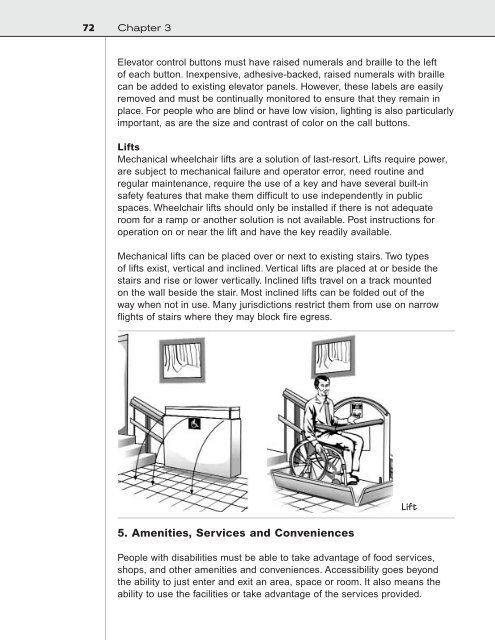Design for Accessibility: A Cultural Administrator's Handbook
Design for Accessibility: A Cultural Administrator's Handbook
Design for Accessibility: A Cultural Administrator's Handbook
You also want an ePaper? Increase the reach of your titles
YUMPU automatically turns print PDFs into web optimized ePapers that Google loves.
72 Chapter 3<br />
Elevator control buttons must have raised numerals and braille to the left<br />
of each button. Inexpensive, adhesive-backed, raised numerals with braille<br />
can be added to existing elevator panels. However, these labels are easily<br />
removed and must be continually monitored to ensure that they remain in<br />
place. For people who are blind or have low vision, lighting is also particularly<br />
important, as are the size and contrast of color on the call buttons.<br />
Lifts<br />
Mechanical wheelchair lifts are a solution of last-resort. Lifts require power,<br />
are subject to mechanical failure and operator error, need routine and<br />
regular maintenance, require the use of a key and have several built-in<br />
safety features that make them difficult to use independently in public<br />
spaces. Wheelchair lifts should only be installed if there is not adequate<br />
room <strong>for</strong> a ramp or another solution is not available. Post instructions <strong>for</strong><br />
operation on or near the lift and have the key readily available.<br />
Mechanical lifts can be placed over or next to existing stairs. Two types<br />
of lifts exist, vertical and inclined. Vertical lifts are placed at or beside the<br />
stairs and rise or lower vertically. Inclined lifts travel on a track mounted<br />
on the wall beside the stair. Most inclined lifts can be folded out of the<br />
way when not in use. Many jurisdictions restrict them from use on narrow<br />
flights of stairs where they may block fire egress.<br />
5. Amenities, Services and Conveniences<br />
Lift<br />
People with disabilities must be able to take advantage of food services,<br />
shops, and other amenities and conveniences. <strong>Accessibility</strong> goes beyond<br />
the ability to just enter and exit an area, space or room. It also means the<br />
ability to use the facilities or take advantage of the services provided.


